Lichenul scleros vulvar este o dermatoza inflamatorie, cronica, progresiva, cu etiologie imprecis elucidata.
Leziunile tipice sunt papule si placi atrofice, alb-ivorii, confluate, prezentand adesea arii de hiperkeratoza, fisuri si echimoze. Asociaza prurit intens. In absenta unui tratament initiat precoce, poate aparea distorsionarea ireversibila a arhitecturii vulvare, afectand puternic calitatea vietii. Pe langa prejudiciul estetic si functional cauzat, lichenul scleros vulvar asociaza si riscul de a dezvolta neoplazie intraepiteliala vulvara, un precursor de carcinom spinocelular invaziv.
Prezentam cazul unei paciente de 54 ani care avea de aproximativ 2 ani o eruptie ano-genitala, pruriginoasa, alcatuita din placi atrofice, alb-ivorii, confluate, insotita de modificari la nivelul arhitecturii vulvare. Suspiciunea clinica de lichen scleros vulvar a fost confirmata histopatologic.
Pacienta a fost tratata initial cu clobetasol propionat 0,05% unguent, urmat de tacrolimus 0,1% unguent, cu remiterea relativ rapida a pruritului. La reevaluarea de la 6 luni, pacienta dezvoltase la nivelul introitului vaginal o placa eritemato-purpurica, cu mici ulceratii pe suprafata, ridicand suspiciunea neoplaziei intraepiteliale vulvare, neconfirmata insa de examenul histopatologic.
In prezent continua tratamentul topic cu tacrolimus 0,1% unguent si este monitorizata clinic lunar.
Sunt trecute in revista datele din literatura referitoare la managementul lichenului scleros vulvar si la riscul transformarii neoplazice.


